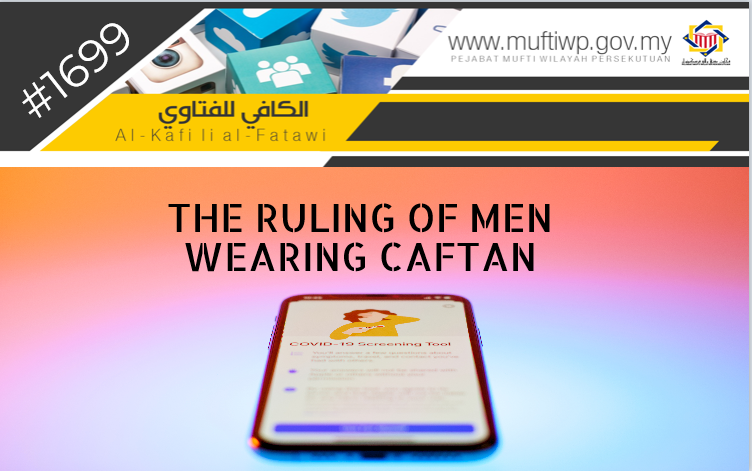Question:
Assalamualaikum wrm.wbt.,
Recently, there is a trend of men wearing their wives’ or mother’s caftans at home. What is the ruling for this? Hope for an explanation.
Answer:
Waalaikumussalam wrm. wbt.,
Alhamdulillah, praise and thanks to Allah for the countless blessings He has blessed us all with. Blessings and salutations to the Prophet Muhammad PBUH, his wives, his family, companions and all those that follow his teachings to the day of judgement.
Wearing beautiful clothing in front each other’s partner for husband and wife is included as a commandment in Islam. This is in accordance with the statement of Allah SWT:
وَعَاشِرُوهُنَّ بِالْمَعْرُوفِ
“And live with them in kindness.”
Surah al-Nisa’ (19)
Imam al-Qurtubi when commenting on the above verse cited an opinion which states the meaning of the verse as: “Do something for the wife in return for what the wife did for the husband.” Then, he followed the statement with the words of Ibn Abbas R.Anhuma who said:
إِنِّي أُحِبُّ أَنْ أَتَزَيَّنَ لِامْرَأَتِي كَمَا أُحِبُّ أَنْ تَتَزَيَّنَ لِي
“Indeed, I love to adorn myself for my wife the same as I love my wife to adorn herself for me.”
Refer Al-Jaami’ li Ahkam al-Quran, Al-Qurthubi (5/97)
Thus, it can be said that the act of adorning oneself in front of each other for husband and wife in terms of appearance and clothing is something which is commanded according to the above syarak evidence. Although, when we come back to the question presented, we would like to state that there are clear syarak evidence regarding this matter. This is according to a hadith narrated by Ibn Abbas R.Anhuma, where he said:
لَعَنَ رَسُولُ اللَّهِ صلى الله عليه وسلم الْمُتَشَبِّهِينَ مِنَ الرِّجَالِ بِالنِّسَاءِ، وَالْمُتَشَبِّهَاتِ مِنَ النِّسَاءِ بِالرِّجَالِ
“Allah's Messenger (ﷺ) cursed those men who are in the similitude (assume the manners) of women and those women who are in the similitude (assume the manners) of men.”
Sahih al-Bukhari (5885)
Imam al-Hafiz Ibn Hajar al-‘Asqalani in his commentary on the above hadith cited the opinion of Imam al-Thabari, who said: “It is impermissible for a man to resemble a woman clothing wise as well as specific adornments for woman and vice versa (it is impermissible for a woman to resemble man).”
Then, Ibn Hajar said:
فَأَمَّا هَيْئَةُ اللِّبَاسِ فَتَخْتَلِفُ بِاخْتِلَافِ عَادَةِ كُلِّ بَلَدٍ فَرُبَّ قَوْمٍ لَا يَفْتَرِقُ زِيُّ نِسَائِهِمْ مِنْ رِجَالِهِمْ فِي اللُّبْسِ لَكِنْ يَمْتَازُ النِّسَاءُ بِالِاحْتِجَابِ وَالِاسْتِتَارِ
As for the type of clothing, it differs according to the state. It may be that for certain races, a woman’s clothing is the same as their men, however, a woman’s clothing is differentiated with hijab and clothing that covered her.
Refer Fath al-Bari, Ibn Hajar (10/332)
While Syeikh Badr al-Din al-‘Aini commented on the hadith saying:
وتشبه الرِّجَال بِالنسَاء فِي اللبَاس والزينة الَّتِي تخْتَص بِالنسَاء مثل لبس المقانع والقلائد والمخانق والأسورة والخلاخل والقرط
(This curse) against the act of a man resembling a woman in terms of clothing and specific adornment such as wearing head covering, necklace, bracelet, anklet and earrings.
Refer ‘Umdah Al-Qari, Al-‘Aini (22/41)
Thus, it is clear from the above opinions that the basis for a man is the prohibition against resembling women in terms of clothing, tone of voice, walk and wearing adornments which are usually worn by women that are specific for them. However, the factor of uruf (custom/tradition/the usual) also plays an important role in this issue especially when it is related to clothing. The reason is it is possible for certain places where their clothing for both man and woman is the same. In this matter, it is not included as an act of tasyabbuh (resembling).
Imam al-Nawawi explains the ruling for a man who resembles a woman (tasyabbuh) saying:
بَلْ الصَّوَابُ أَنَّ تَشَبُّهَ الرِّجَالِ بِالنِّسَاءِ وَعَكْسَهُ حَرَامٌ لِلْحَدِيثِ الصَّحِيحِ
Accurately put, the act of a man resembling a woman and vice versa (a woman resembling man) is haram according to sahih hadith.
Refer Al-Majmu’, Al-Nawawi (4/445)
Conclusion
To conclude, we would like to state, in the issue of resembling the opposite gender in terms of clothing, it is divided into three parts as the following:
- For the type of clothing which are worn by both genders, then it is permissible for both man and woman to wear it, considering the original ruling for something which is its permissibility.
- Clothing that are specific for man, then it is haram for women to wear it.
- Clothing that are specific for woman, then it is haram for men to wear it.
Thus, considering the uruf of our society, we are inclined to state that caftans are clothing which are specific for woman. Thus, it is haram for men to wear it. Furthermore, this prohibition is to close the doors that could lead to the act of tasyabbuh the opposite gender. Wallahua’lam.
Lastly, we pray to Allah SWT so that we are given the correct understanding in practising this religion. Amin.


